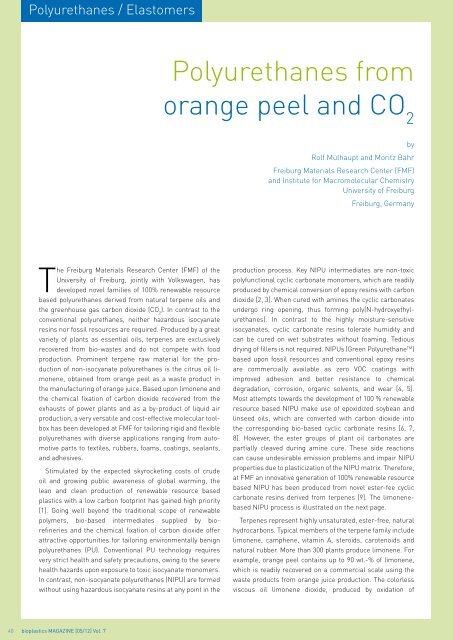bioplasticsMAGAZINE_1205
bioplasticsMAGAZINE_1205
bioplasticsMAGAZINE_1205
Create successful ePaper yourself
Turn your PDF publications into a flip-book with our unique Google optimized e-Paper software.
Polyurethanes / Elastomers<br />
Polyurethanes from<br />
orange peel and CO 2<br />
by<br />
Rolf Mülhaupt and Moritz Bähr<br />
Freiburg Materials Research Center (FMF)<br />
and Institute for Macromolecular Chemistry<br />
University of Freiburg<br />
Freiburg, Germany<br />
The Freiburg Materials Research Center (FMF) of the<br />
University of Freiburg, jointly with Volkswagen, has<br />
developed novel families of 100% renewable resource<br />
based polyurethanes derived from natural terpene oils and<br />
the greenhouse gas carbon dioxide (CO 2<br />
). In contrast to the<br />
conventional polyurethanes, neither hazardous isocyanate<br />
resins nor fossil resources are required. Produced by a great<br />
variety of plants as essential oils, terpenes are exclusively<br />
recovered from bio-wastes and do not compete with food<br />
production. Prominent terpene raw material for the production<br />
of non-isocyanate polyurethanes is the citrus oil limonene,<br />
obtained from orange peel as a waste product in<br />
the manufacturing of orange juice. Based upon limonene and<br />
the chemical fixation of carbon dioxide recovered from the<br />
exhausts of power plants and as a by-product of liquid air<br />
production, a very versatile and cost-effective molecular toolbox<br />
has been developed at FMF for tailoring rigid and flexible<br />
polyurethanes with diverse applications ranging from automotive<br />
parts to textiles, rubbers, foams, coatings, sealants,<br />
and adhesives.<br />
Stimulated by the expected skyrocketing costs of crude<br />
oil and growing public awareness of global warming, the<br />
lean and clean production of renewable resource based<br />
plastics with a low carbon footprint has gained high priority<br />
[1]. Going well beyond the traditional scope of renewable<br />
polymers, bio-based intermediates supplied by biorefineries<br />
and the chemical fixation of carbon dioxide offer<br />
attractive opportunities for tailoring environmentally benign<br />
polyurethanes (PU). Conventional PU technology requires<br />
very strict health and safety precautions, owing to the severe<br />
health hazards upon exposure to toxic isocyanate monomers.<br />
In contrast, non-isocyanate polyurethanes (NIPU) are formed<br />
without using hazardous isocyanate resins at any point in the<br />
production process. Key NIPU intermediates are non-toxic<br />
polyfunctional cyclic carbonate monomers, which are readily<br />
produced by chemical conversion of epoxy resins with carbon<br />
dioxide [2, 3]. When cured with amines the cyclic carbonates<br />
undergo ring opening, thus forming poly(N-hydroxyethylurethanes).<br />
In contrast to the highly moisture-sensitive<br />
isocyanates, cyclic carbonate resins tolerate humidity and<br />
can be cured on wet substrates without foaming. Tedious<br />
drying of fillers is not required. NIPUs (Green Polyurethane TM )<br />
based upon fossil resources and conventional epoxy resins<br />
are commercially available as zero VOC coatings with<br />
improved adhesion and better resistance to chemical<br />
degradation, corrosion, organic solvents, and wear [4, 5].<br />
Most attempts towards the development of 100 % renewable<br />
resource based NIPU make use of epoxidized soybean and<br />
linseed oils, which are converted with carbon dioxide into<br />
the corresponding bio-based cyclic carbonate resins [6, 7,<br />
8]. However, the ester groups of plant oil carbonates are<br />
partially cleaved during amine cure. These side reactions<br />
can cause undesirable emission problems and impair NIPU<br />
properties due to plasticization of the NIPU matrix. Therefore,<br />
at FMF an innovative generation of 100% renewable resource<br />
based NIPU has been produced from novel ester-fee cyclic<br />
carbonate resins derived from terpenes [9]. The limonenebased<br />
NIPU process is illustrated on the next page.<br />
Terpenes represent highly unsaturated, ester-free, natural<br />
hydrocarbons. Typical members of the terpene family include<br />
limonene, camphene, vitamin A, steroids, carotenoids and<br />
natural rubber. More than 300 plants produce limonene. For<br />
example, orange peel contains up to 90 wt.-% of limonene,<br />
which is readily recovered on a commercial scale using the<br />
waste products from orange juice production. The colorless<br />
viscous oil limonene dioxide, produced by oxidation of<br />
40 bioplastics MAGAZINE [05/12] Vol. 7


















